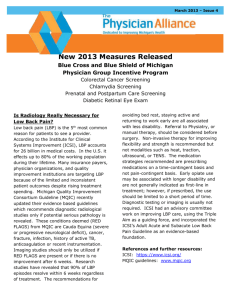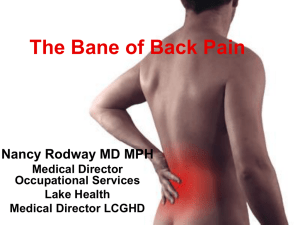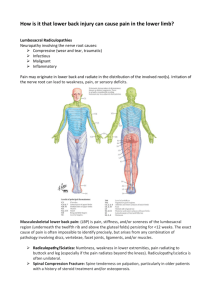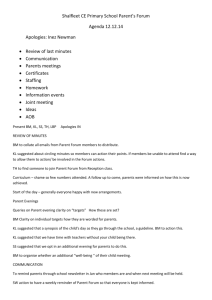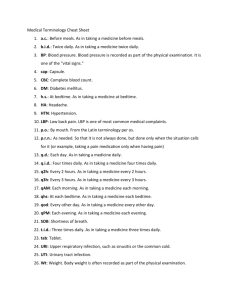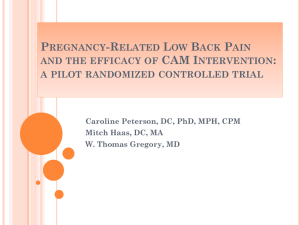Document
advertisement
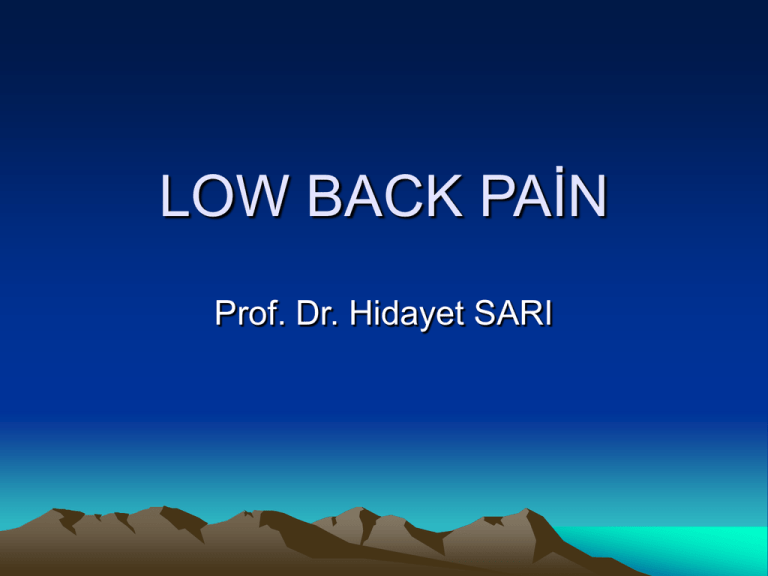
LOW BACK PAİN Prof. Dr. Hidayet SARI KEY POINTS • Low back pain (LBP) is the second most comman condition seen primary care practice, and the most common problem seen by musculosceletal specialists. It is essential that physicians be comfortable with the nuances of diagnosis and teratment of LBP. KEY POINTS • Less common causes of LBP such as infection (fever and focal pain) and cancer (weight loss, unexplained pain,and oncologic risk factors) must be overlooked. If the pain persists and is unexplained, then the case must be investigated further. KEY POINTS • Magnetic resonance imaging (MRI) images have a 30% false-positive rate, and therefore must be used in a discrminating manner. Remember that most patients with acute LBP and without neurologic signs and symptoms will respond to conservative therapy, and need no diagnostic tests. KEY POINTS • Prolonged bed rest is harmful. An extended period of inactivity is a risk factor for converting acute LBP into chronic LBP. Start an appropriate regimen of exercise as soon as possible to preserve strength and flexibility in the muscles that support the lumbar spine. KEY POINTS • Sensitization of peripheral or central pain processing systems will explain some cases of chronic LBP that persist despite the correction of the anatomical factors. Therefore, the first 3 to 6 months of assessment and treatment of patients with LBP are critical with regard to preserving and optimizing function of the lumbar spine. INTRODUCTİON • LBP can affect up to 80% of the population at some point in their lives, making it second only to the common cold as an illness affecting the general population, and the fourth or fifth most comman reason for a visit to the physician’s office in the United States. INTRODUCTİON • Acute LBP usually resolves spontaneously, but up to 10% progress to chronic LBP resulting in temporary or permanent disability. This results in a loss of more than 1,000 work days per 1,000 workers each year, costing more than $20 billion annually and disabling several million individuals in the United States alone at any on time. INTRODUCTİON • Risk factors for the development of LBP include heavy manual work, poor job satisfaction, exposure to vibration, cigarette smoking and pregnancy. A sedentary lifestyle is also probably a cause. • Most patients with acute and chronic LBP have “idiopathic“ LBP, meanng that despite testing, no clear cause can be found for their pain. INTRODUCTİON • Most patients who present with acute LBP in the absence of significant neurologic physical findings need no diagnostic tests and will respond to conservative management. • Patients who do not respond to a conservative regimen may need imaging studies, and rarely surgery ETIOPATHOGENESİS • Any of the components of the lumbosacral spine when combined with related conditions listed in the subsequent text may be responsible for LBP. I- VERTEBRAL BODY (fracture,osteoporosis, metastatic disease, sickle cell disease and infection) II- INTERVERTEBRAL DİSC (herniation and infection) III-JOINTS (osteoarthritis and ankylosing spondylitis) A- Apophyseal joints B- Sacroiliac joints ETIOPATHOGENESİS IV- LİGAMENTS (strain and rupture) A- Anterior and posterior longitudinal ligaments) B- Interspinous ans supraspinous ligaments C- Iliolumbar ligaments D- Apophyseal ligaments. V- NERVE ROOTS (herniated nucleus pulposus and spinal stenosis) VI- PARASPİNAL MUSCULATURE (strain and spasms) IV- LİGAMENTS (strain and rupture) A- Anterior and posterior longitudinal ligaments) B- Interspinous ans supraspinous ligaments C- Iliolumbar ligaments D- Apophyseal ligaments. V- NERVE ROOTS (herniated nucleus pulposus and spinal stenosis) VI- PARASPİNAL MUSCULATURE (strain and spasms) VII- PAIN FROM ADJACENT STRUCTURES (referred pain) A- Kidney (pyelonephritis and peripheric abscess). B- Pelvic strucures (pelvic inflammatory disease, ectopic pregnancy, endometriosis and prostate disease) C- Vascular (aortic aneurysm and mesenteric thrombosis) D- Intestinal (diverticulitis) VIII- Pain amplification syndromes where there is no identifiable abnormality of the peripheral tissue, but there is localized or widespread hyperalgesia (e.g., myofascial pain and regional forms of fibromyalgia). PREVALENCE • Prevalence of LBP ranges from 38 to 39 per 1,000 population, with female sex, white ancestry, and increasing age being independent risk factors for increased incidence. CLINICAL MANIFESTATIONS I. Clinical history of the patients is of great importance in obtaining information regarding associated symptoms and establishing a pattern of pain. A thorough review of symptoms that would suggest a nonmechanical cause for LBP is required. CLINICAL MANIFESTATIONS • I. Clinical history A- Fever or chills would raise the possibility of an infectious process. B- Weight loss, chronic cough, change in bowel habits, or night pain may suggest malignancy C- Similar pain or morning stiffness in different areas of the body would increase the suspicion of a more generalized rheumatic condition such as ankylosing spondylitis, psoriatic arthritis, or reactive arthritis (ReA9 CLINICAL MANIFESTATIONS • I. Clinical history D- If fatigue or sleep disturbance is present, in the setting of a diffus pain syndrome, the diagnosis of fibromyalgia should be considered. E- Morning stiffness or back pain that improves with exercise should prompt consideration of a spondyloarthropathy such as ankylosing spondylitis. CLINICAL MANIFESTATIONS II- PAIN The quality of pain, its distribution, and modulating factors are helpful in determining etiology. CLINICAL MANIFESTATIONS • II- PAIN A- Onset of pain 1. Sudden onset especially following trauma suggests injury. 2. Indolent onset suggests a nonmechanical cause. 3. Episodic or colicky pain suggests an intra-abdominal or pelvic source. B- Localization of pain 1. Localized pain provides a focus for the diagnostic workup. 2. Radicular pain, suggesting nerve root impingement. 3. Pain thatn is not easily localized, migratory, or multifocal suggests fibromyalgia. CLINICAL MANIFESTATIONS • II- PAIN C- Modulating factors 1. Exercise-induced pain, especially on walking, suggests osteoarthritis or spinal stenosis, whereas pain that improves with exercise especially following morning stiffness suggests an inflammatory process, for example, a spondylarthropathy. 2. Valsalva maneuvers such as coughing, sneezing, or bowel movements that worsen pain suggest nerve root impingement. CLINICAL MANIFESTATIONS III- NEUROLOGİC SYMPTOMS. The presence of neurologic symptoms should be spesifically sought in patiets with LBP. Their presence can not only help to delineate the site of the abnormality but also can prompt more rapid intervention. CLINICAL MANIFESTATIONS • III- NEUROLOGİC SYMPTOMS. A- Weakness, numbness, or paresthesias in a dermatomal distribution suggests nerve root impingement. 1. The most common cause of nerve root impingement in individuals between the ages of 20 and 50 years is a herniated nucleus pulposus. 2. Radicular symptoms in individuals older than 60 are more likely to be secondary to spinal stenosis resulting from osteoarthritis. PHYSICAL EXAMINATION • Spesific abnormalities and provacative maneuvers designed to elicit pain associated with certain synrromes should be tested for in patients with LBP. CLINICAL MANIFESTATIONS • III- NEUROLOGİC SYMPTOMS. B- Bowel or bladder dysfunction suggests the presence of cauda equina syndrome and should prompt emergent investigation. C- LBP in the presence of fever and neurologic symptoms should trigger the mind to the possibility of an epidural abscess. PHYSICAL EXAMINATION 1- PATIENT IN STANDING POSITION A. Note the alignment of the spine looking for a pelvic tilt may indicate a paravertebral spasm , for loss of normal lumbar lordosis that could indicate either spasm or ankylosis, and for evidence of structural scoliosis. B. Evaluate gait, station, and posture. C. Evaluate the patient’s ability to flex, hyperextend, rotate, and tilt the spine. PHYSICAL EXAMINATION 2- PATIENT IN SUPINE POSITION A. Straight leg raising (SLR).Flex each leg at the hip with knee extended and record the angle at which pain occurs and whether it radiates below knee. A true positive SLR test is defined as radicular pain radiating belox the knee, is a sensitive indicator of nerve root impingement, and should be confirmed by extending the knee while the patient is sitting, to eliminate malingering. 2- PATIENT IN SUPINE POSITION B. A crossed SLR test (radicular pain contralateral to the leg being raised) is highly predicitive of nerve root compromise. C. Evaluate hip and knee range of motion to eliminate these areas as a source of pain. D. Carry out thorough neurologic examination and symptoms define a “root signature,” allowing the physician to localize the source of the problem and potentially correlate it with the results of the imaging test. 3- PATIENT IN PRONE POSITION A. Look for evidence of sciatic notch tenderness, sometimes seen in sciatica. B. Results of the femoral stretch test (extending the hip) may be positive in L4 radiculopathy. C. Palpate bony structures, especially the vertebral structures, for localized tenderness, and examine for the resence of trigger points, not only in the low back but also in other areas of the body. DIAGNOSTIC INVESTIGATIONS I- Laboratory tests should be performed as indicated by the history and physical examination, age of the patient, and duration of symptoms. A. The erytrocyte sedimentation rate (ESR) and C-reactive protein, reflect acute phase reactants and will usually be elevated in infection, inflammatory joint disease, and metastatic malignancies. B. Determinations of calcium, phosphorus, and alkaline phosphatase levels screen for metabolic bone diseases. C. Serum and urine protein immunoelectrophoresis should be performed if multipl myeloma is suspected because of the coexistence of back pain, elevated ESR, and anemia. IMAGING STUDIES A- Imaging studies are not performed until the patients fails a trial of conservative therapy or unless neurologic or constitutional symptoms are present. IMAGING STUDIES 1- Plain films should be taken as an initial study in the evaluation of LBP. a. Anteroposterior, lateral end cone-down views of the lower two interspaces are standard procedure. b. Oblique views will identify subtle spondylosis and help to visualize the neural foramina, but are not routinely necessary. c. Fleksion extension views may be obtained to document instability and range of motion. IMAGING STUDIES 2- Bone scintigraphy is useful as a screening study when malignancy (other than multipl myeloma), infection, or occult fracture, which are not visualized on plain films, are suspected. IMAGING STUDIES 3- Magnetic resonance imaging (MRI) has revolutionized the imaging of the lumbosacral spine and can visualize both bony and soft tissue structures well. MRI is now the imaging modality of choice for imaging intraspinal pathology. The principal problem with MRI is the high rate of false-positive results. Up to 30% of asymptomatic individuals will be shown to have significant abnormalities on MRI. Therefore, MRI-defined abnormalities need to ve viewed in the context of the findings based on history and physical examination. IMAGING STUDIES 4- Computed tomography (CT) scan. When used without intradural contrast, CT scan is the modality of choice for delineating the bony structures of the spine (e.g., to detect spinal stenosis). With the addition of intrathecal metrizamid, the sensitivity for detecting neural involvement is enhanced.. CT scan dopes not detect intraspinal pathology as well as MRI does, and false-positive results may also be present as in MRI. IMAGING STUDIES 5- Myelography outlines the dural theca and its contents after injection of a contrast media into the dural sac. This is a good study to delineate neural compression. It remains the study of choice when metal hardware is present or when arachnoiditis is suspected. Myelography is slowly falling from favor because of its invasiveness, side effects, and because of the improvement in imaging techniques with MRI and CT scan. IMAGING STUDIES 6- Diskography is performed by injecting dye into the disk space. If symptoms are reproduced during the procedure, iı may be particularly helpful, especially if other imaging studies have been nondiagnostic. IMAGING STUDIES 1- Degenerative disk disease. Radigraphic abnormalities correlate poorly with symptoms and they must be correlated with the patient’s history and physical examination findings. a. Narrowing of the intervertebral disc. b. Vacuum phenomenon defined as radiolucency in the disc space. c. Traction osteophytes defined as anterior osteophytes on the lumbosacral spine indicative of spinal instability. IMAGING STUDIES 2- Osteoarthritis a. Osteophytes formation b. Facet joint arthritis. c. Spinal stenosis d. Acquired spondylolisthesis IMAGING STUDIES 3- Congenital and developmental defects a. Spondylosis refers to the dissolution or failure of the develoment of the neural arch, typically noted as a lucency in the “neck” of the “Scotty dog” noted on oblique spine radiographs (the “eye” of the Scotty dog is the pedicle, the “ear” is the superior articulation of that vertebral body, and the “neck” is the pars interarticularis). Failure of the pars can lead to slippage (usually anteriorly) of one vertebral body over the other. b. Spondylolisthesis is slippage of one vertebral body on another. It can be a consequence of spondylolysis or an acquired condition. c. Transitional vertebrae, with lumbarization of S1 or sacralization of L5. d. Schmorl’s nodes are defects in the vertebral end plates that allow vertikal disk herniation. e. Scoliosis or kyphosis. IMAGING STUDIES 4- Spondyloarthropathies (ankylosing spondylitis, ReA, psoriatic arthritis, and arthritis associated with inflammatory bowel disease). a. Erosions or sclerosis of the sacroiliac joints are best seen in a Ferguson (sacroiliac) view of the pelvis, a special view that allows better visualization of the joint. b. Syndesmophytes Calcification of the ligamentous structures leads to a bridging of the adjacent vertebral bodies. IMAGING STUDIES 5- Neoplasm a. Typically leads to destruction of the vertebral body. b. Loss of the outline of the pedicle on the anteroposterior films. c. Pathologic fracture. 6- Infection should be suspected when destruction of adjacent vertebral end plates is present or bony destruction is accompanied by constitutional symptoms. IMAGING STUDIES 7- Miscellaneous a. Osteoporosis. Loss inmineralization, compression fractures with characteristic anterior wedging, “fish mouth” appearanca to the intervertebral spaces. b. Metabolic bone disease (i.e., osteomalacia, Paget’s disease, or hyperparathyroidism) c. Sickle cell disease. DIFFERENTIAL DIAGNOSİS I- VERTEBRAL BODY DISEASE A. Fracture B. Multiple myeloma C. Metastatic cancer D. Infection II- INTERVERTEBRAL DISC DISEASE A- Herniation B- Infection DIFFERENTIAL DIAGNOSİS III- JOINT DISEASE A- Apophyseal joint disease due to osteoarthritis B- Sacroiliac joints IV- LIGAMENTOUS DISEASE A- Anterior and posterior long ligaments. B- Interspinous and supraspinous ligaments. C- Iliolumbar ligaments D- Apophyseal ligaments. DIFFERENTIAL DIAGNOSİS V- NERVE ROOT IMPINGEMENT A- Herniated nucleus pulposus. B- Spinal stenosis. C- Neoplasm. VI- PARASPINAL MUSCULATURE A- Fibromyalgia B- Myofascial (localized pain). VII- REFERRED PAIN A- Renal B- Pelvic C- Vascular D- Gastrointestinal. TREATMENT I- Because more than 90% of cases of LBP are self-limiting and resolve spontaneously, any treatment algorithm must account for this and should avoid immediate laboratory or imaging studies unless constitutional symptoms, weakness, or neurologic dysfunction suggests that there is an urgent problem. TREATMENT II- ACUTE TREATMENT A- Rest versus activity. Many longitudinal studies suggest that prolonged rest, and/or “fear” on the part of patients that activity will worsen their pain, are associated with a higher likelihood of the acute LBP becoming chronic. Patients should avoid extended periods of inactivity. B- Spinal traction has no direct benefit, but may help enforce bed rest if this is desirable for a very short period of time. TREATMENT II- ACUTE TREATMENT C- Pharmacologic treatment 1. Pain control. This is often brought about with the use of single or combination drug therapy with nonsteroidal anti-inflammatory drugs (NSAIDs), other classes of analgesics, and topical pain patches. (i.e., Lİdoderm 5%) 2. Muscle relaxants. The mechanism of action of these drugs is not entirely clear, but they are helpful in some patients with acute LBP. Examples include cyclobenzaprine 5 to 10 mg either as a single nighttime dose or up to a maximum of every 6 hours methocarbamol 750 to 1500 mg up to every 6 hours, and chlorzoxazone 500 to 750 mg up to every 6 hours. Benzodiazepines such as diazepam may also be used for a limited period of time. TREATMENT II- ACUTE TREATMENT D- Physical measures 1. Moist heat. Heating pads, hot tubes, steam, and sauna baths. 2. Massage, ultrasound. 3. Bracing for any extended period of time may lead to muscle weakness. TREATMENT III- Failure of conservative treatment as outlined at the end of 4 to 6 weeks is considered an indication to initiate a diagnostic workup and consider surgical intervention. The workupshould include plain radigraphs of the lumbosacral spine, and usually an MRI of the lumbosacral spine, as well as any other laboratory studies deemed necessary based on the patient’s history and physical exam. TREATMENT IV- OTHER TREATMENT MODALITIES A. Injection of myofascial trigger points with lidocaine alone or combined with corticosteroids if the patient exhibits only a few spesific areas of tenderness. B. Facet or nerve block procedures can be both diagnostic and therapeutic, but require spesific skills and experience. C. Transcutaneous electrical nerve stimulator(TENS). D. Physical therapy. TREATMENT V- Invasive intervention should be considered if there is a failure of conservative therapy and when there is a radiographically demonstrable anatomic lesion that could explain the pain, or when malignancy or infection cannot be excluded with noninvasive techniques. TREATMENT V- Invasive intervention A- Surgery should rarely be performed before 2 months of conservative therapy, except in circumstances that require urgent intervention such as worsening neurologic deficit. However, a delay of more than 6 months may also be unwise becauseof a higher risk of the development of chronic pain. TREATMENT V- Invasive intervention B- Types of surgical intervention. These operations usually are performed after conservative therapy has failed and interactable pain, other sensory findings, or motor weakness are present. Depending on the skill and experience of the surgeon, disease, artificial disc replacements are being developed and hold promise for less invasive surgery that does nor disrupt the normal bony structures. TREATMENT V- Invasive intervention B- Types of surgical intervention. 1- Laminectomy or hemilaminectomy. Removal of all or part of the lamina while preserving the apophyseal joints or in the case of spinal stenosis trimmingthe joints to decompress the neural tissues. 2- Laminotomy or hemilaminotomy An opening is created in the lamina without it being totally removed. TREATMENT V- Invasive intervention B- Types of surgical intervention. 3- Discectomy. Removal of the nucleus pulposus by standard surgical approach or fiberoptic approach. 4- Microdiscectomy. Removal of a portion of the herniated nucleus pulposus under microscopic guidance with a fiberoptic scope. 5- Spinal fusion. The preciseindications for this surgery are controversial; this is usually performed in combination with one of the above operation. TREATMENT VI- Chronic pain may arise from a failure of conservative or more aggressive therapies, and these patients renmain difficult to treat even in specialized setting. A subset of this group has fibromyalgia. TREATMENT VII- REHABILITATION AND EXERCISE Flexibility and strengthening exercise is frequently recommended for patients with LBP. Basic principles regarding rehabilitation in these patients should be followed, and physical therapists are very helpful in instructing patients in these programs. TREATMENT VII- REHABILITATION AND EXERCISE A- Postsurgical patients 1. Ambulation is encouraged early and prolonged sitting is avoided. B- Nonsurgical patients. “Exercises” for LBP probably should not be initiated until the acute phase of recovery has been completed and the patient can move freely without pain, whereas resumption of normal “activities” should be encouraged as early as possible. In the beginning of an exercise program, patients should be instructed to begin with only three to five repetitions of each exercise and proceed slowly to increase the repetitions. TREATMENT VII- REHABILITATION AND EXERCISE B- Nonsurgical patients. 1- Pelvic tilt. Buttocks are tightened, and the lumbar spine is flattened isometrically. 2- Modified sit-ups. With the patients supine, knees bent, and arms at the side, the head and shoulders are lifted off the ground for 5 seconds. 3- Knee-chest stretch. With the patients supine, knees bent, and arms at the side, each knee is brought top the chest one at a time and held with the arms for 5 seconds. Then the knee is extended and that leg is lowered to the ground slowly. 4- Wall exercise. The patients leans againist the wall with the feet approximately 1 foot from the wall, depending on the height of the patients. Knees are then bent to approximately 45 degrees or until the lumbar spine feels flat againist the wall for a few seconds. The patient then returns to the upright position. TREATMENT VII- REHABILITATION AND EXERCISE C- Other suggestions 1- Weight reduction 2- Increase aerobic fitness with walking, swimming, or other low impact activities. Do stretching activities as a workup before aerobics. 3- Lifestyle modifications such as proper lifting techniques (while lifting, the knees should be flexed and the back straight, and twisting while lifting should be avoided); use of a firm mattress to sleep on; and vocational training that may be of help. PROGNOSIS I- In long-term follow-up, most patients with LBP without a seious underlying disorder such as malignancy, herniated nucleus pulposus with spinal cord or nerve root compression, or significant spinal stenosis will do well with a short period of rest, a conservative exercise program (in some cases, supervised by physical therapist) that emphasizes flexion and extension exercises, stretcing regimens, and gradual aerobic conditioning and weight loss. PROGNOSIS II- Factors associated with a poor prognosis include malignancy, fracture, multiple level spinal stenosis, or herniated nucleus pulposus, or other conditions with spinal cord or nerve root impingement taht is not corrected surgically in a timely manner. PROGNOSIS III- Patient characteristics that usually indicate the need for surgery are sphincter and sexual dysfunction due to the compression of the conus medullaris or cauda equina and persistenet radicular symptoms especially if associated with neurologicmotor deficits that progress. The surgical procedure chosen is determined by the anatomic lesion that needs correction, and the training and skill of the surgeon called upon to do the surgery. Choosing a surgeon with extensive experience and good outcomes is an important role tahat mediacal consultatns can fulfill on behalf of the patients with LBP PROGNOSIS IV- Serious intraoperative or perioperative complications can occur during low back surgery if important neorologic structures are comromised due to surgical erro, infection or bleeding that causes pressure and subsequent damage to the spinal cord or nerve roots. PROGNOSIS V- Patients with LBP who have uncorrected pain for more than 3 to 6 months may have difficulty being totally free of pain even after the anatomic cause of their original pain is corrected. This may occur because of behavioral (e.g., fear of movement leading to inactivity and isolation) or neurobiologic (e.g., “sensitization” of peripheral or central pain processing systems) reasons, or misdiagnosis (e.g., pain coming from a different cause than that originally treated), or may be due to multiple causes.
